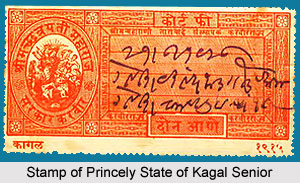 The Princely State of Kagal Senior was one of the prominent princely states of India that was administered by a native prince under the guidance of the British authorities. The princely state was under the indirect control of the British Empire in India. Kagal Senior State covered a total area of 115.1 sq miles and comprised of a total population of 49,867 in the year 1931. Kagal Senior constituted of atleast 5 distinct blocks of land, which were entangled with the territory that belonged to the Junior Branch, all in the central part of Kolhapur, their common monarch. The Princely State of Kagal Senior was incorporated as a part of the Kolhapur Agency; and was also a part of the Deccan States Agency.
The Princely State of Kagal Senior was one of the prominent princely states of India that was administered by a native prince under the guidance of the British authorities. The princely state was under the indirect control of the British Empire in India. Kagal Senior State covered a total area of 115.1 sq miles and comprised of a total population of 49,867 in the year 1931. Kagal Senior constituted of atleast 5 distinct blocks of land, which were entangled with the territory that belonged to the Junior Branch, all in the central part of Kolhapur, their common monarch. The Princely State of Kagal Senior was incorporated as a part of the Kolhapur Agency; and was also a part of the Deccan States Agency.
History of Princely State of Kagal Senior
The Ghatges, an old family of Kshatriya Marathas, were the ruling family of the princely state of Kagal. The family obtained Kagal as a jagir from the king of Bijapur around 1572. Shivaji sanctioned the grant in the year 1668. Shivaji II of Kolhapur confiscated the jagir due to insubordination and rebellion. The region was reassigned to the Ghatges in the year 1778 as per the terms of a peace treaty with Scindia. In 1800, the ruling jagirdar was deposed and the state of Kagal was handed over to Serjerao or Sarkharam Dev Rao Ghatge, who was also a member of the family. It was given as a reward for his function in supporting Scindia to raise the Patwardhan siege of the state of Kolhapur. The 2 members of the family continued to claim the jagir until the year 1805, when it was segregated, Serjerao retaining the larger region of Kagal Senior and Yeshwant Rao received the smaller part of Kagal Junior.
The State of Kagal Senior was again confiscated in the year 1825 and the town was acquired by force. But the intervention of the British East Indian Company compelled the Kolhapur durbar to assure that it would never perturb Ichalkaranji or Kagal. The princely state of Kagal made a proposal for independence with encouragement from the v authorities of the Kolhapur administration. But in the year 1842, the British administration ruled that Kagal was a part of the domain of Kolhapur state and the jagirdars of Kagal needed to comply with the commands of the Chhatrapati. Later in 1882, the jagirdar of Kagal Senior was appointed as regent of Kolhapur for Shivaji IV, and after the death of the native ruler, the eldest son of the regent was adopted as the successor of the throne.
The Princely State of Kagal Senior was a jagir of the princely state of Kolhapur. The native ruler or Jagirdar of Kagal Senior exercised jurisdictional powers. He held the title of Sarjerao Vajarat Maab and was formally addressed as Meherban Jagirdar.
In the year 1947, after the withdrawal of the British Government and the Partition of India, the last native ruler of the princely state of Kagal Senior acceded his state to the newly formed Dominion of India, also known as Union of India. At present, Kagal is a town located in the district of Kolhapur in Maharashtra state, India.



















